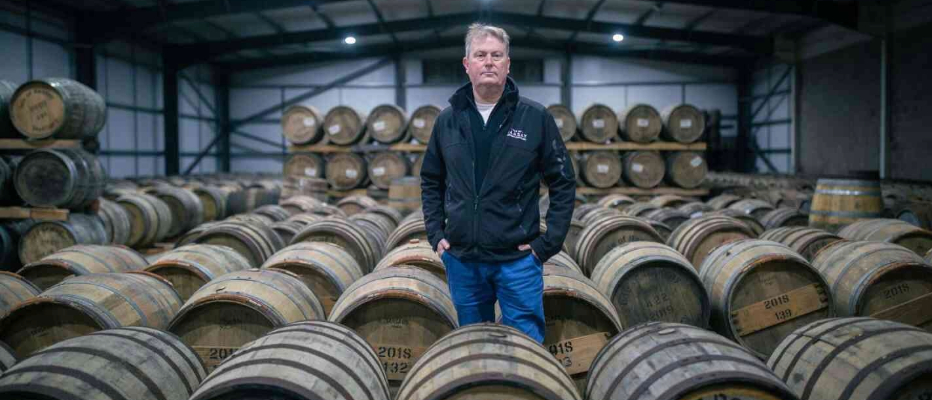Super Early Deadline
30 November 2025
Judging
Date
24 & 25 March 2026
Winners Announcement
22 April 2026
30 November 2025
24 & 25 March 2026
22 April 2026

Alasdair Day began his distilling journey with an aspiration to continue his great-grandfather’s legacy and keep his family’s connections to the Scottish whisky industry alive. Today he is the co-founder of R&B Distillers, one of the few indigenous producers of Scotch whisky and the company behind Isle of Raasay Distillery, where Day is the master distiller. In a discussion with the London Spirits Competition, he talks about his family's legacy in whisky, the challenges facing the Scottish spirits industry, and the innovative sustainability practices driving R&B Distillers and the Isle of Raasay Distillery.
My connection to whisky was established way back in the early 1900s when my great-grandfather took over J&A Davidson, where he began as an office boy. J&A Davidson was a licensed grocery store with brewers and whisky blenders. My grandfather ran the place until he retired, leaving me his "cellar book," a ledger that contains all of the recipes for blends the company created from 1899 to 1916. I recreated one of my great-grandfather's blends called the Tweeddale from the book, which I released in 2010. And that’s how I set foot in the Scotch whisky industry. Two years later, I came up with a business plan to build a small distillery and I was glad that I came across Bill Dobbie, who was looking to invest in a distillery and create Scotland’s Leading New Wave Spirits & Drinks Business. Together we opened the R&B Distillers Limited and the Isle of Raasay Distillery. Our first Isle of Raasay Hebridean single malt was launched in November 2020.
Also read: Six Types of Whiskeys Every Whiskey Drinker Should Know

Image Title: Alasdair Day with co-founder Bill Dobbie
I am the master distiller who is in charge of research & development, spirit quality, distillery process design and sustainability.
At our distilleries, our long-term production planning is directly tied to our ten-year sales plan. We plan on launching special releases that will help us create future sales and marketing campaigns around those new products. As part of our plan, we have several key themes that we are working on, such as the impact of different oak species in maturation, the effect of a barley’s variety or geography on a spirit’s character and how different types of yeast create different flavour characteristics.
[[relatedPurchasesItems-63]]
I think a good distiller is someone who has the ability to create flavour with complexity, depth and balance.
A distiller needs to think ahead and ensure that everything is designed, implemented and managed over a very long period of time, probably decades. Therefore, planning in advance can be quite hard.

Image Title: Master Distiller Alasdair Day
Our Isle of Raasay Hebrdean single malt is lightly peated with dark fruit flavours. It is made using our six-cask recipe. It has great complexity, depth and balance of flavours, which makes it ideal for mixing in cocktails like Highball and Manhattan or drinking on its own.
What are the current challenges the spirits industry is facing?
I personally think that it is quite a challenging time to be a part of the Scottish whisky industry for several reasons. There is a slowdown in demand in export markets like Germany, China, and Japan. The new US administration plans to bring back a 25% tariff on Scotch whisky. Moreover, the last two duty raises on spirits in the UK will severely impact the pricing of Scotch whisky in the country. If those headwinds are not enough, there are a large number of new Scotch whisky and world whisky brands that are now competing for the same shelf space.
Also read: Indian Whisky: A Rising Star in the Global Market
I'm always trying to continuously learn more about all of the elements that go into making excellent Scotch whisky and spirits. Though it's impossible for me to know everything, I aim to learn as much as I can about the industry.

Image Title: Alasdair Day in the dunnage warehouse on Raasay
We provide all of our draff to the local crofters on Raasay; all of the sheep and cattle on the island have been fed on our draff at some point in time. Also, we use our other byproducts, like pot ale and spent lees, to preheat our wash before it goes into the wash still, reducing the energy it will consume to heat the wash.
We have another heat recovery step that comes in the mashing stage. There is a heat exchange that is used to cool the wort from 64-80°C down to 20°C before adding the yeast to the wort in the washbacks. The heat recovered is then used to preheat the next water for mashing, significantly reducing the energy required in our process. We are also working on a third heat recovery step that will recover heat from the condenser cooling water, which we will use to heat our accommodation and visitor centre, which could potentially reduce our carbon footprint.
Header image photographed by Kristine Potter
Related links
Kevin O'Gorman: The Art and Evolution of Whiskeys at Midleton
How Alex Witt Uses His Distilling And Brewing Talent To Excel In The Irish Whisky Industry
Show your spirits where it matters. Get your products tasted by top bartenders, buyers and experts at the London Competitions — enter now.